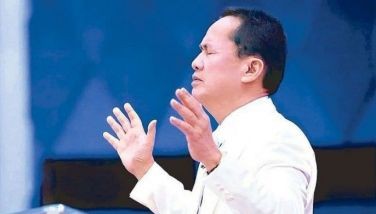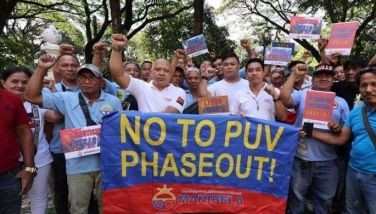#Journeyto30 Tyranny of the majority
MANILA, Philippines – “A time to heal, a time to build,” says The STAR’s headline on Jan. 22, 2001 – a day after the nation ousted former president Joseph Estrada and installed then Vice President Gloria Macapagal-Arroyo as its new leader after four days of a peaceful popular uprising in the heart of the nation’s capital.
The ruling middle class and elite, angered by more than a month of intricate and tense impeachment proceedings, rallied at EDSA once more to call for Estrada’s resignation. This, after Estrada’s Senate allies voted not to open the envelope supposedly linking Estrada to a bank account of a certain Jose Velarde purportedly containing kickbacks from an illegal numbers game.
Facing pressure from both protesters and dwindling support from Cabinet members, local executives and foreign ambassadors, Estrada resigned and left Malacañang. The second EDSA Revolution was a “success.”
This chapter in our country’s political history comes to fore once again as we remembered and reflected about the 30th anniversary of the 1986 EDSA People Power Revolution this past week.
The second EDSA Revolution is a textbook case of societies’ tendencies toward mob rule and undermining democratic institutions. The million-strong people power at the EDSA Shrine in 2001, and the subsequent pro-Estrada riots that happened in May of the same year, bypassed legal and democratic means of regime change such as impeachment and elections.
It could be argued that the Senate was dominated by Estrada allies and, therefore, could not be relied upon to give an objective guilty verdict, hence the need for another people power. But that argument failed to find justification after Senate President Aquilino Pimentel Jr. initiated the opening of the second envelope to members of the media, which revealed that Jose Velarde was Jaime Dichavez, not Estrada.
As The New York Times reporter Seth Mydans put it, “The popular uprising took place when it became clear that due process – his impeachment trial in the Senate – would not produce the result many people hoped for: his removal by constitutional means.”
Nevertheless, this is not to justify the corruption and excesses of the Estrada administration. Democratic institutions like the Office of the Ombudsman and the Sandiganbayan later tried and found Estrada guilty of plunder in 2007.
But if the second EDSA Revolution had failed to take place, we would not have placed another despot in power in the form of Arroyo. If it did not happen, the May 1 riots and the other attempts against her administration would not have occurred and added legitimacy to her rule through her successful defense of Malacañang. And Arroyo would not have vied and won in a flawed election in 2004.
Arroyo was so cunning and skillful in political maneuvering that she deflected any attempt against her administration like a Teflon pan. And that is where the danger of a tyrannical majority lies.
It is tyranny when a majority puts in place an autocrat and legitimizes its decadence, corruption and tampering of democratic institutions by doing nothing against it. It is tyranny when an overbearing majority thinks of itself as above an enlightened, critical minority. It is tyranny when a majority stifles democratic freedoms of expression, opinion and assembly by branding it as counterproductive and anti-nationalist.
The concept of a tyrannical majority is crucial to the 1986 EDSA People Power Revolution because it is the opposite of the term. Unlike the 2001 revolution, it was the first true “people power” revolution as it involved nationwide collective actions from different colors in the socio-political spectrum. And it found justification in the fact that Filipinos no longer had other legal recourses to depose a dictator, such as impeachment or election, because Marcos had corrupted every democratic institution in the country and tampered with democratic processes for regime change.
It didn’t just happen in Metro Manila – it was happening around the country, such as in in the Cordilleras, where the Kalingas and Tingguians resisted the Chico River Dam Project from 1974 to 1986 that threatened to displaced them from ancestral domains. Such as in Escalante, Negros Occidental in 1985 where townsfolk protested against the lack of genuine agrarian reform. Such as in many parts of Mindanao where rebel groups like the Moro National Liberation Front (MNLF) and the Moro Islamic Liberation Front (MILF) waged armed struggle for independence in the wake of government neglect for the plight of Muslim Filipinos.
The peaceful uprising in EDSA was just the culmination of a two-decade people power revolution that began during the First Quarter Storm of 1972.
The concept of a tyrannical majority is crucial because it undermines the true spirit of people power. When the majority revolts to advance its interests and undermine the minority, it is not people power. When the majority elects candidates to public office without regard for their blatant corrupt practices – that is not people power. When a majority votes on the basis of popularity, histrionics, mass appeal, public image, saber rattling, fear mongering, emotional appeal, regionalism and without regard to the factuality and feasibility of their grandiose yet illusory platforms – that is not people power.
A tyrannical majority assumes that the minority has no legitimate issues to raise, and are too critical and undermining of the nation’s progress. This is argumentum ad populum, as the majority has no monopoly of political correctness. The minority may be critical – in fact, we should all be – but it is because they too have valid points to argue on what will make this nation progress. And yet, the majority censors critical and independent thinkers just because they are a minority.
Societies can make mistakes collectively, just as in Nazi Germany and in America during racial segregation. The voice of the people is not always the voice of God.
- Latest
- Trending





























